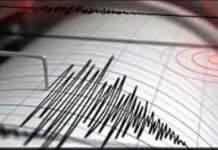Flash floods triggered by torrential rains continued to cause devastation across the country on Saturday, as rescuers struggled to reach out to the affected population, while tens of thousands of people fled their homes in the north after a fast-rising river destroyed a major bridge.
Powerful flash floods in Khyber Pakhtunkhwa caused the Kabul River to swell, sweeping away the large Tangi Bridge near Munda Headworks overnight, cutting off some districts from road access. Downstream, fears of flooding around the river banks prompted around 180,000 people in the district of Charsadda to flee their homes, according to disaster officials, with some spending the night on highways with their livestock.
According to Charsadda district administration, the high floods in Swat and Kabul rivers have inundated low-laying areas in Charsadda and Nowshera districts affected thousands of people. Mohib Banda, Bara Banda, Pashtoon Ghari and villages near the bank of Kabul River were flooded where rescue workers shifted people to safer places with the help of boats.
Relief camps were set up at Pabbi and Nowshera for flood victims. Most of the people visited their relatives for stay. The gushing water also swept away cattle and destroyed standing crops. The KP chief minister has allowed his helicopter to be used for floods relief operations.
The Nowshera deputy commissioner urged people to immediately shift to safer places as 300,000 cusecs of water was passing through Kabul River at Nowshera.
The water level started receding in Panjkora River, while food items and other essentials were being provided to flood victims at relief camps in Swat.
On the directives of Prime Minister Shehbaz Sharif, the PM’s adviser, Amir Muqam, visited flood-hit Swat and Bajaur and met the victims. He directed WAPDA officials to expedite work on electricity restoration in flood-hit areas of Khyber Pakhtunkhwa. Over in Shangla, three people were killed and various interconnecting roads were swept away by floods that wreaked havoc in the area.
More than 150 small power generating units were damaged in different areas of Shangla, including Kana and Alpuri valley. Electricity supply to major areas of Shangla was disrupted, while crops and orchards were also damaged due to floods that inundated the area.
Heavy flood also swept away small bridges situated in Khan Khawar, Lowe Khawar and Amnawi Khawar where people were facing hardships due to severing of linking bridges. Main portion of Ranial Road near Alpuri Bisham was also damaged due to floodwater that destroyed hundreds of houses in the district.
Lower Kohistan District Police Officer (DPO) Zulfiqar Jadoon said that at least 16 people were killed, including five women and three children, due to the rains and flash floods during the last two days in Lower Kohistan.
Talking to the media, he said that the water flow of devastating streams and drains including Dubeer Pattan and Kehal had started to decrease, while the work of clearing landslides at different places on the Karakoram Highway was also in progress.
Rains have partially subsided in the upper parts of the Hazara division, including Mansehra and Upper Kohistan, while Kaghan Highway has been opened for traffic. Water flow in Kunhar and Dubeer rivers has started to decrease. After three days of closure, the Kaghan highway was opened for traffic. Landslides were cleared at Battal Jalkad by the heavy machinery of Kaghan Development Authority (KDA) and the traffic was restored.
Gilgit-Baltistan has also been severely affected due to rains and floods, says a Gilgit-Baltistan government report issued on Saturday. The report estimated that from June 30 to August 26, 2022, 14 people have died due to floods and rains, while three were injured.
On the other hand, five people, including three children, drowned in floodwaters in different incidents. Reports from Noreen Colony of Nawabshah said there children had drowned in different localities. Those who lost their lives were identified as Imran, Zeba and Gul Banu. The residents of the locality retrieved their bodies after hectic efforts.
Also, according to reports from different devastated districts, waterborne diseases as well as other viral infections claimed the lives of 15 more victims. Those reportedly died at so-called relief camps or along the roadsides were mostly children.







